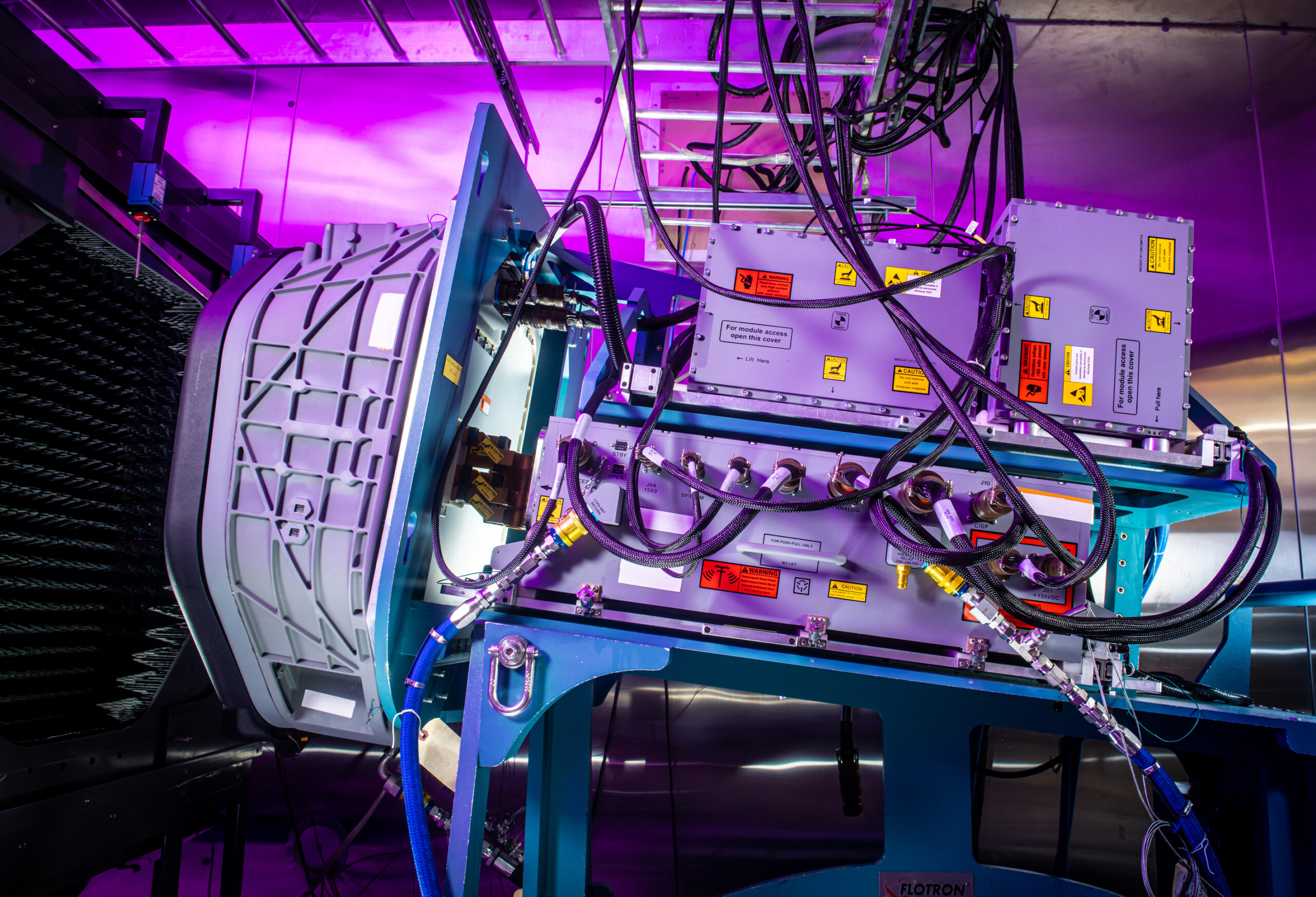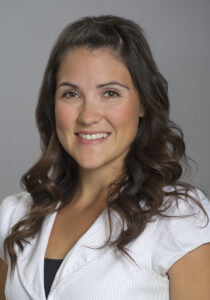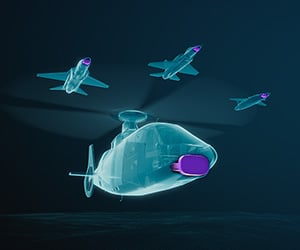
Testing of the APG-82 AESA radar inside Raytheon Intelligence & Space’s Forest, MS, facility.
Raytheon Intelligence & Space has led the world in the development of tactical, fighter radar technology since the mid-1940s, and changed the face of combat in the early 1970s with the introduction of the all-weather, multimode APG-63 radar for the F-15.
With the F-15 celebrating its first flight 50 years ago, we met with the women behind deploying the Eagle’s first fire-control radar and discussed some additional advancements they are making in aircraft mission systems. Breaking Defense chatted with Michelle Styczynski, vice president of F-15 programs, Secure Sensor Solutions, who oversees the APG-82 radar program; and Michelle Moholt, technical director and chief architect for the Raytheon Distributed Aperture System and Common Open Secure Mission Computing.
Breaking Defense: What was the significance of this development and in making the F-15 the world’s most capable air superiority fighter of its day?

Michelle Styczynski, vice president of F-15 programs, Secure Sensor Solutions, Raytheon Intelligence & Space, who oversees the APG-82 radar program.
Styczynski: I’m not biased when I say that the radar is the premier avionics system on the F-15.
When we initially developed the radar, it was to support the air defense and air superiority mission of the F-15A and B. It later became a staple of the F-15 C and D fleets. Over time, the F-15 community was challenged to take on air-to-surface missions, air interdiction, and deep strike. With that, the F-15E was developed, along with the APG-70 radar to support both air superiority and air-to-surface missions.
This radar is a huge source of pride for us as a company. Recently, we celebrated our 50th anniversary of providing radars for the F-15, where more than 250 team members joined together to reflect on the work that went into developing the APG-63, APG-70 and APG-82.
We’re proud of our 50-year history supporting the F-15. We were there for the first F-15, and we’ve been on every F-15 since.
Breaking Defense: What are some of the early radar milestones, and what is it about those early radars that still impress you today?
Styczynski: Our radars are true engineering marvels in terms of what we are able to design and produce, and the capability they bring to aircrews.
It’s worth noting that without the APG-63, one of the first fire-control radars, we might not be in the radar game today.
From there, another milestone for us was the development of a software-programmable signal processor. Initially introduced for the APG-63 follow on, the APG-70, it allowed the system to accommodate new modes and weapons through software reprogramming rather than by hardware retrofit.
Lastly, I will say the integration of AESA technology into our radar systems was a major milestone for us; it allowed us to deliver increased capability to aircrews. The APG-62(V)2 was the first radar to be upgraded to AESA technology.
Breaking Defense: What are the challenges associated with maintaining these legacy radars because a lot of them are still out there?
Styczynski: Obsolescence is an ongoing concern, regardless of the type of program; it could happen at any phase of the product life cycle — development, sustainment, or production. It is certainly a challenge with the APG-82 and has exponentially impacted the program over the last couple of years.
For example, our customers for the F-15E and F-15EX are looking for form-fit-function compatibility with the existing system, all the while we’re trying to give aircrews additional capabilities that are more lethal, as well as affordable. It’s certainly hard work to make it all come together but protecting aircrews in the skies is why we take this work on.
Breaking Defense: Raytheon Technologies is becoming known for the leadership of women in this field. How are female engineers leading the charge in bringing fresh perspectives and innovations?

Michelle Moholt, technical director and chief architect for the Raytheon Distributed Aperture System and Common Open Secure Mission Computing.
Moholt: From my standpoint, I think women are truly the leaders of innovation across the company, and especially within RI&S.
I’ve seen this firsthand as a member of the RI&S Innovation Review Committee, a group that I serve as the cyber co-chair on. Women are submitting patents in numbers that I’ve never seen before.
Additionally, there are many women in leadership roles related to innovation and engineering processes, including leading efforts to mature our digital twins and DevSecOps, as well as overseeing implementation of model-based systems engineering across the enterprise.
It’s clear to me, at least, that Raytheon Intelligence & Space values the perspectives women bring to the organization. They’re pushing us to lead different initiatives within the engineering organization so that we can design and deliver the next generation of airborne capabilities.
Styczynski: I definitely second Michelle’s statements. Since we became Raytheon Technologies, there has been an increased focus to amplify diversity, equity and inclusion efforts across every part of our company. There’s not a day that goes by that I don’t see a success story of a woman, or a person of color being highlighted in terms of their innovative contributions to the organization.
There are multiple, different leadership programs that have come out of the merger that are focused specifically on women. I’m a part of one of them called WILL Rise; WILL stands for Women in Line Leadership. In this, I lead a cohort of eight women, and we talk about coming up through the ranks, the challenges that we face, and most importantly, we impart knowledge to them, in terms of how they can navigate their careers. It’s women learning from women about how we can support each other to be better leaders and better engineers at the end of the day.
Breaking Defense: How does Raytheon’s legacy systems and body of knowledge/experience help to inform development of newer systems? In other words, what is the connective tissue between yesterday’s radars and the array of airborne systems you have today?
Moholt: Across Raytheon Technologies and specifically across RI&S, we have a wide variety of products — more than just radars. We work on advanced sensors, cyber solutions, software, training, you name it.
To say that we have a vast body of knowledge may be an understatement. But having experience with this wide array of technologies allows us to understand more fully the battlespace — getting to that larger scope and CONOPS. It also allows us to develop more thoughtful solutions for our customers.
On the whole, it comes down to collaboration, within our business and on a larger scale across Raytheon Technologies. We’re gathering not only lessons learned from failures, but also from successes so that we can drive that into our next generation of products.
Breaking Defense: As you point out, Raytheon Intelligence & Space is more than radars. So what are some key innovations that the business is developing in areas like mission computing and 360-degree sensors for situational awareness?
Moholt: We’re world renowned for our fire-control radars, but we’ve expanded our airborne portfolio to also include advanced electronic warfare, landing guidance, sensors and mission computing solutions
I get to work on our next-generation sensors and mission computers, specifically the Raytheon Distributed Aperture System, which we call RDAS, and our Common Open Secure Mission Computing, or COSMC.
RDAS builds upon our existing Electro-Optical Distributed Aperture System, which we call EODAS, from the F-35. Providing 360-degree situational awareness and increased survivability, it innovates off EODAS in that it is air cooled. We don’t need cooling from the airplane, which gives us the ability to lower size, weight and power. In addition to that, we’ve added capabilities like laser warning.
Our COSMC solution is basically a platform-agnostic mission-computer processing element that hosts the RDAS software and firmware. It serves as the connective tissue across all of the different sensors that are hosted on that platform, helping to increase performance, while decreasing SWaP.
This mission computer was developed using model-based systems engineering and gives us the ability to adapt the design and rapidly deploy capabilities. It is a Sensor Open Systems Architecture, or SOSA, aligned so we can upgrade obsolescence issues quickly. Again, it’s all about getting capability out to aircrews and operators.
More than just developing the individual technologies, we’re also looking at connecting them. Integrating together our electronic warfare systems, our situational awareness, and our radars, will provide an increased battlespace advantage for aircrews and operators.

Raytheon Distributed Aperture System or RDAS is a 360-degree sensor suite that delivers unmatched situational awareness in the most contested environments. The system is airframe agnostic and tailorable to multiple platforms.
Breaking Defense: Raytheon Intelligence & Space recently introduced a new AESA radar called PhantomStrike that is designed for platforms other than 4th and 5th-generation tactical fighter aircraft. Tell me about that.
Styczynski: In the 2017-2018 timeframe, there was a change in the market where customers, both foreign and domestic, were looking for a low-cost attritable solution. Rather than making an iterative change to our current APG-79 and APG-82 AESA radars, the team started fresh.
They developed a fire-control radar solution that was lightweight with low-power consumption, as well as being affordable. It’s designed for SWaP-constrained air platforms such as UAVs, rotary wing, and light attack.
Similarly to what Michelle said regarding the RDAS, PhantomStrike is also air-cooled rather than liquid cooled, which helps to reduce overall weight. The total system is about 100 pounds. It’s also half the price of one of our fire-control AESAs, and it gets a lot of range for the value.

The PhantomStrike AESA radar harnesses the fire control power of a fighter in its lightest, smallest form factor ever.
Breaking Defense: What should be the takeaways from this piece?
Styczynski: What’s important is the people. I am lucky to work with a lot of people who are devoted to what we do. There’s not a day in which those folks don’t give 150, 200 percent. We may have issues, we may stumble, we may have a problem, but what I always tell my team is we always figure it out.
We see F-15EX breathing new life into the F-15 aircraft and we’re excited to be a part of that. The people and their passion for what they do brings me back to the job every single day, despite some days being more difficult than others.
A lot of love and passion goes into the delivery of a radar system. Many creative people are part of the process to develop, build, and sustain radars, and they are proud to be a part of it.
Moholt: For me, it’s that women are driving the innovation within Raytheon. We are taking more of our existing portfolio and systems, and we’re advancing them. We’re looking at ways to not only get rid of obsolescence, but also to increase capability for aircrews and rapidly get it to market so that we can maintain our competitive advantage.
We’re constantly innovating, pushing the edges of technology and on what we can do, and constantly trying to find new ways to expand.





















